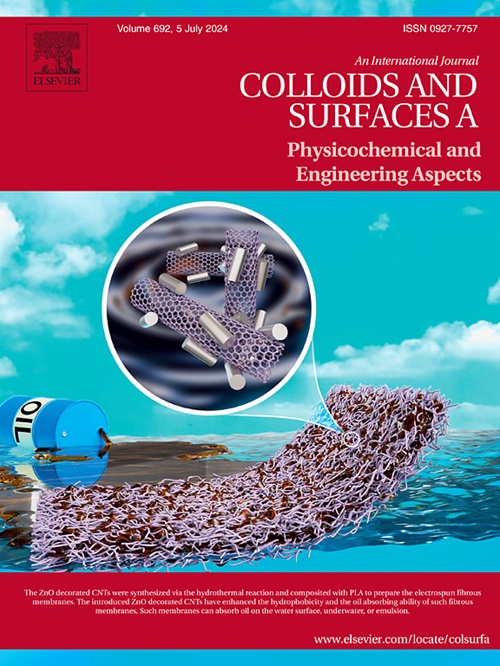Exploring the multifaceted potential of Ga3+ doped ZnO nanoparticles in biomedical and forensic applications
IF 4.9
2区 化学
Q2 CHEMISTRY, PHYSICAL
Colloids and Surfaces A: Physicochemical and Engineering Aspects
Pub Date : 2025-04-27
DOI:10.1016/j.colsurfa.2025.137058
引用次数: 0
Abstract
This study presents the synthesis and multifunctional evaluation of Ga3+-doped Zinc oxide (ZnO) nanoparticles (NPs) using a solution combustion method with honey as a biogenic fuel. Ga3+ concentrations from 1 to 11 mol% were incorporated into ZnO, yielding particles with a hexagonal wurtzite structure, confirmed by X-ray diffraction (XRD), and scanning electron microscopy (SEM), transmission electron microscopy (TEM), X-ray photoelectron spectroscopy (XPS) analysis verified successful Ga3+ integration without secondary phase formation, diffuse reflectance spectroscopy (DRS), Raman spectroscopy, Fourier-transform infrared spectroscopy (FTIR), and photoluminescence (PL) spectroscopy. PL studies revealed a strong UV emission peak at 385 nm and broad visible emission from 420–660 nm under 248 nm excitation, highlighting their potential in anti-counterfeiting (AC) applications through UV-activated security inks and labels. For forensic applications, ZnO:1Ga3+ NPs demonstrated excellent visualization of latent fingerprints (LFPs), capturing detailed ridge and pore features on porous and non-porous surfaces, making them a reliable, non-destructive tool for personal identification. Biological assessments revealed notable antioxidant activity, with ZnO:1Ga3+ NPs effectively scavenging DPPH and H2O2 radicals, along with inhibiting ADP-induced platelet aggregation, suggesting therapeutic potential in mitigating oxidative stress and thrombotic conditions. Additionally, cytotoxicity tests on A549 lung cancer cells showed a dose-dependent reduction in cell viability, achieving a 68.52 % decrease at 100 μg/mL and an IC50 of 164.28 μg/mL. In contrast, HEK-293 normal embryonic kidney cells retained over 90 % viability across the same concentration range, highlighting the anticancer potential of ZnO:1Ga3+ NPs. To evaluate the specific advantages of Ga3+ doping, control experiments with undoped ZnO NPs were conducted. Compared to ZnO:1Ga3+, the undoped ZnO showed higher cytotoxicity toward HEK-293 cells (IC50 = 587.88 μg/mL), confirming the improved biocompatibility imparted by Ga3+. These findings establish ZnO:Ga3+ NPs as versatile materials suitable for AC, forensic, and biomedical applications, combining stability, biocompatibility, and targeted efficacy, making them promising candidates for advanced technological and therapeutic solutions.
探索Ga3+掺杂ZnO纳米颗粒在生物医学和法医应用中的多方面潜力
本研究以蜂蜜为生物燃料,采用溶液燃烧法合成了Ga3+掺杂氧化锌纳米颗粒(ZnO)并对其进行了多功能评价。将浓度为1 ~ 11 mol%的Ga3+掺入ZnO中,得到具有六方细锌矿结构的颗粒,通过x射线衍射(XRD)、扫描电子显微镜(SEM)、透射电子显微镜(TEM)、x射线光电子能谱(XPS)、漫反射光谱(DRS)、拉曼光谱、傅里叶变换红外光谱(FTIR)等分析证实Ga3+成功集成,没有形成二次相。和光致发光(PL)光谱。PL研究表明,在385 nm处有很强的紫外发射峰,在248 nm激发下有420-660 nm宽的可见光发射峰,这突出了它们在紫外线活化的防伪油墨和标签中的应用潜力。对于法医应用,ZnO:1Ga3+ NPs表现出出色的潜在指纹(LFPs)可视化,捕获了多孔和非多孔表面上的详细脊状和孔隙特征,使其成为可靠的,非破坏性的个人识别工具。生物学评估显示,ZnO:1Ga3+ NPs具有显著的抗氧化活性,可以有效清除DPPH和H2O2自由基,同时抑制adp诱导的血小板聚集,表明其具有缓解氧化应激和血栓形成的治疗潜力。此外,对A549肺癌细胞的细胞毒性试验显示,细胞活力呈剂量依赖性降低,在100 μg/mL时降低68.52% %,IC50为164.28 μg/mL。相比之下,HEK-293正常胚胎肾细胞在相同浓度范围内保持超过90% %的活力,突出了ZnO:1Ga3+ NPs的抗癌潜力。为了评价Ga3+掺杂的具体优势,进行了未掺杂ZnO纳米粒子的对照实验。与ZnO:1Ga3+相比,未掺杂的ZnO对HEK-293细胞表现出更高的细胞毒性(IC50 = 587.88 μg/mL),证实了Ga3+提高了细胞的生物相容性。这些发现表明ZnO:Ga3+ NPs是一种多用途材料,适合于交流、法医和生物医学应用,具有稳定性、生物相容性和靶向功效,使其成为先进技术和治疗解决方案的有希望的候选者。
本文章由计算机程序翻译,如有差异,请以英文原文为准。
求助全文
约1分钟内获得全文
求助全文
来源期刊
CiteScore
8.70
自引率
9.60%
发文量
2421
审稿时长
56 days
期刊介绍:
Colloids and Surfaces A: Physicochemical and Engineering Aspects is an international journal devoted to the science underlying applications of colloids and interfacial phenomena.
The journal aims at publishing high quality research papers featuring new materials or new insights into the role of colloid and interface science in (for example) food, energy, minerals processing, pharmaceuticals or the environment.

 求助内容:
求助内容: 应助结果提醒方式:
应助结果提醒方式:


